
Reviewing: “Real Life Pesach Cooking” by Miriam (Pascal) Cohen. Mesorah Publications, Ltd. 2024. ISBN-10: 1-4226-3968-1.
“Real Life Pesach Cooking: Approachable Family Friendly Recipes to Enhance Your Passover,” by popular kosher food blogger Miriam (Pascal) Cohen, delivers what it promises. The recipes are comfortably traditional with innovative twists for delicious meals that are not too labor intensive. Cohen includes a guide to choosing recipes ideal to make for day and overnight Chol Hamoed trips, when kosher food is either unavailable or beyond your budget.
Cohen has developed a loyal following with her blog, Overtime Cook and her two previous cookbooks: “Real Life Kosher Cooking” and the follow up, “More Real Life Kosher Cooking.” She is known for creating recipes that won’t chain you to the kitchen but have lots of flavor.
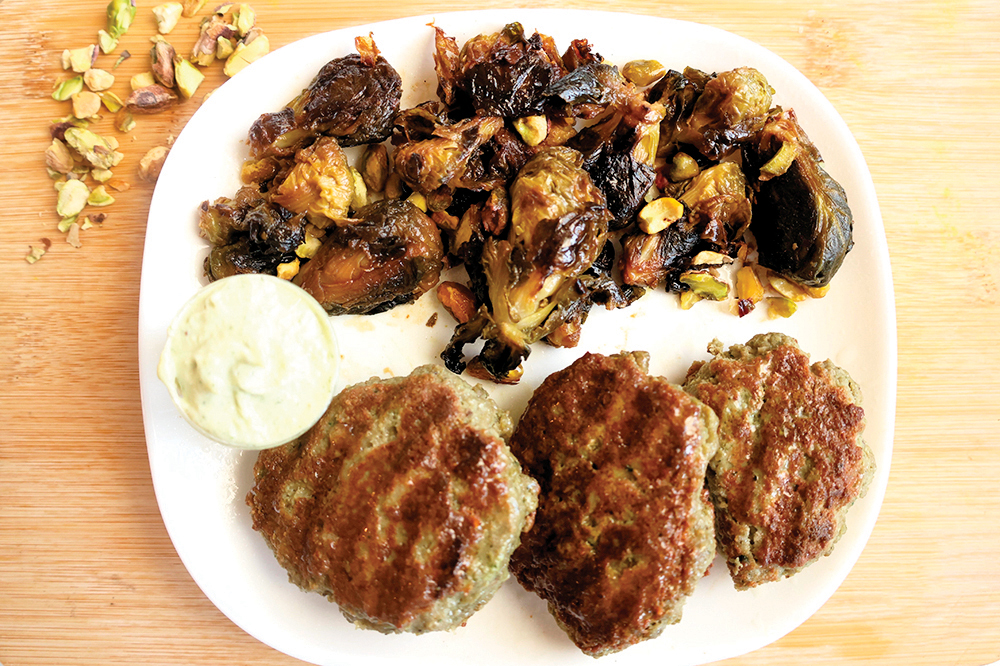
The Real Life Pesach Cookbook recognizes that most of the week is either Shabbos or Yom Tov when we will be eating enhanced holiday meals. That means plenty of chicken and meat variations, and many options for vegetable and potato side dishes. For multi course meals, there are soups and appetizers to start and desserts for a sweet finish. There are a few dairy and fish meals for a Chol Hamoed change of pace. These recipes would be good for any holiday meal. You can always swap out the potato starch for cornstarch or flour during the year.
Cohen admits that Pesach cooking was not always easy for her, but that’s one of the reasons she wrote the book. In the introduction she explains her motivation: “I’m like you. I struggle to keep my kitchen clean, to get dinner on the table in a timely manner and I also struggle with self-doubt. I’m here to tell you…it’s okay. I did it and so can you.” She writes that she’s not ‘aspirational,’ aiming for gorgeous gourmet every day. But she is inspirational. Her writing is warm and personal. You feel as though you’re conversing with a helpful friend, not reading a textbook. Cohen’s followers will enjoy reading about tweaks she has made to her recipes since her marriage in 2020. In the introduction to a recipe for Savory Sweet Potato and Shallot Soup, she writes that although she loves sweet potatoes and butternut squash, her husband doesn’t like them. She discovered that making them more savory than sweet resulted in a taste they could both enjoy. She began creating more recipes with broccoli after learning broccoli is one of her husband’s favorite foods.
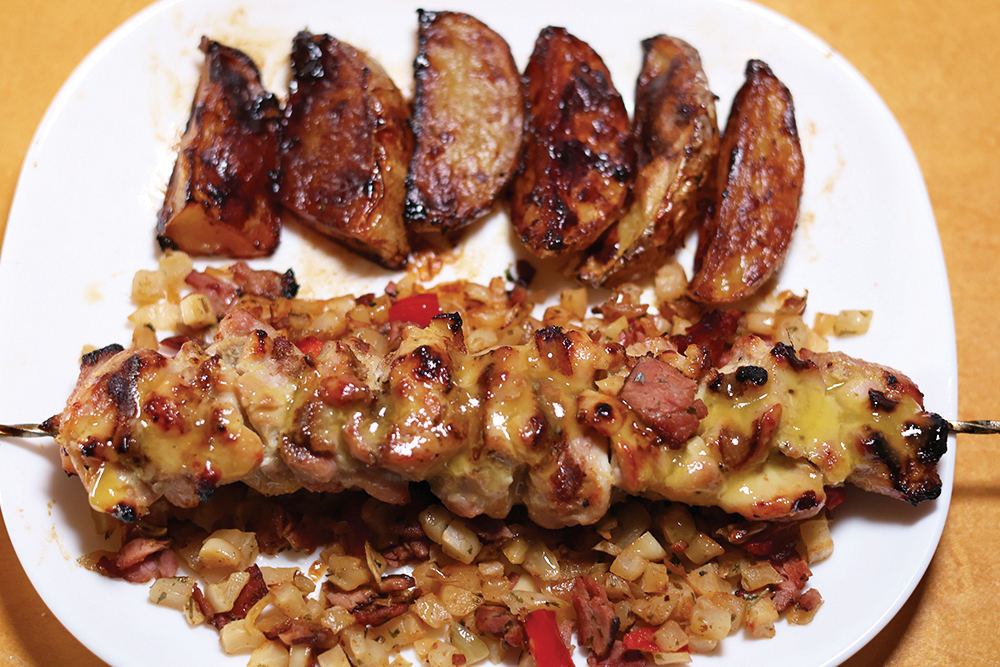
There are a few takeaways from the recipes in this book. Cohen uses as few processed Pesach ingredients as possible, and relies instead on combinations of fresh, readily available items. Very few recipes call for matzah-based ingredients. The book does start out with a genius recipe for using matzah balls, baked so they are firm, as slider buns for pulled brisket. There is one recipe using matzah farfel. I don’t think there are any with matzah cake meal, an ingredient that gives baked goods that definitive, not so pleasant matzah taste. Cohen uses a lot of potato starch and almond flour. Anyone allergic to nuts should preview the recipes carefully. It’s a good idea to review the book and plan recipes to try, so if you buy something for one dish that’s a little pricey, like pistachio nuts, you can use it for another recipe that calls for the same ingredient.
Since the stores are just now getting in their Pesach supplies, I used some ingredients that aren’t KP but basically the same, like potato starch and almond flour. Here are the highlights from my week of cooking.
For main dishes, I made Mini Lamb Patties with Creamy Herb Dipping Sauce, Crockpot Chol Hamoed Dinner (chuck roast); Onion Smothered Flanken (I used brisket), Wine Glazed Meatballs, General Tso Chicken, Orange-Ginger Chicken Kebabs, Grilled Chicken with Honey Lime Marinade, Honey-Nut Salmon and Flounder with Pistachio Pesto. The lamb patties are in the appetizer section but make an excellent dinner. The lamb is not spiced but the herbed mayo-based sauce, with fresh mint and parsley, give it hints of Sephardic style flavor. After I blended the herbs in the food processor, I decided to make the mayo from Cohen’s recipe in the book instead of using my regular jarred version. We all know Pesach mayo is one of the least appealing Pesach substitutions, so I thought this was an ideal time to make my own as a Pre-Pesach test. What a difference! Homemade mayo would be a luxury during the year but I think it’s a Pesach necessity. The herb infused homemade mayo was a smooth, rich dip. I used the remainder at other meals.
The General Tso chicken was a huge hit with my tasters. The chicken cubes are coated with potato starch and fried, then topped with a sweet spicy sauce. It is similar to the everyday version but with its own distinct style. I didn’t miss the soy sauce. The Crockpot Chol Hamoed dinner was basically a pot roast and potatoes, but of course with Miriam’s creative touch. The crockpot is filled with shredded cabbage, onions, crushed tomatoes and spices before adding the roast, and later, the potatoes. The flavors were reminiscent of a savory stuffed cabbage but with sliced meat and potatoes. I have only used my crockpot for Shabbat cholent so I am thrilled to realize there is more that can be done with it. This roast was delish and it really was nice to prepare it in the morning, go about my day and have dinner all ready. The other dishes were all excellent, with flavors from the marinades that made each one special. I enjoyed the Orange Ginger Chicken Kebabs, but realized too late that some extra sauce would have been nice to use as a glaze. Next time.
The recipe for Onion Smothered Flanken suggests using any meat good for ‘low and slow’ cooking. I used a brisket and made it for Shabbat dinner. The caramelized onions over the very soft brisket made for a scrumptious dish. The recipe says to cook for five hours. I cooked it for four hours on a Thursday night, de-fatted and reduced the gravy, then refrigerated it overnight. Late Friday afternoon, I sliced the meat, returned it to the pan with the gravy and put it in the oven for probably another hour or two. A definite year-round keeper.
I make one or two fish dishes weekly so I was happy to try the Honey-Nut Salmon and Flounder with Pistachio Pesto and Roasted Lemons. Cashew nuts over the salmon added a nice crunch, although for my taste, I put in too much tomato paste and would tone that down next time. Pistachio pesto was a nice change of pace from pesto with pine nuts especially with the addition of some fresh lemon. Flounder is somewhat bland so it needs a good sauce for more assertive flavor.
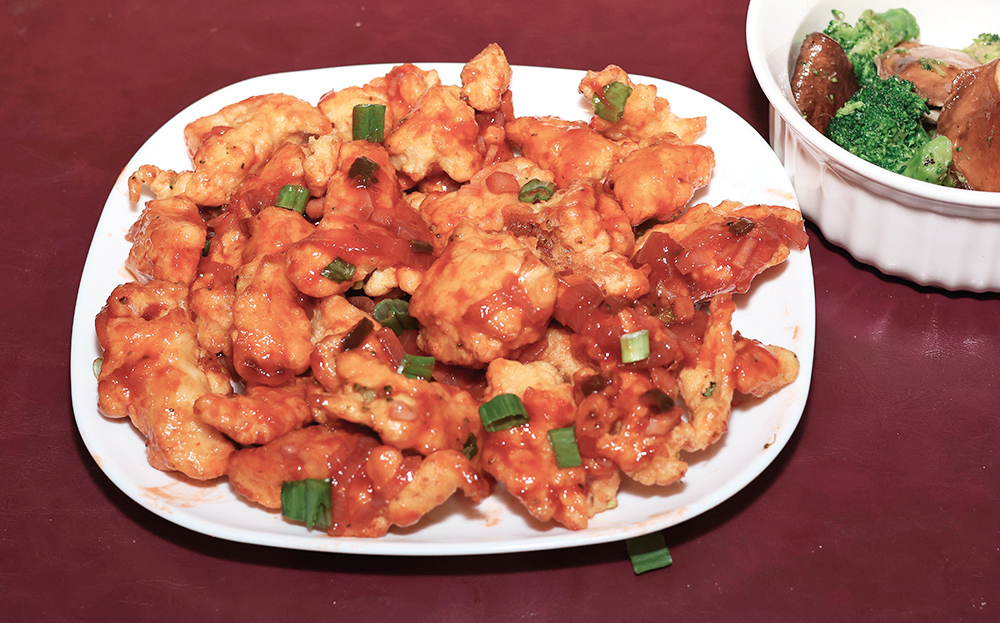
(Credit: Bracha Schwartz)
Braising is a technique that gives a lot of flavor to meat or vegetables and braised dishes can stay safely on a hot plate, making them ideal for Shabbat and Yom Tov. I made several braised vegetable side dishes that were excellent but required more time than the recipe instructs for the right taste and texture. The braised mushrooms and pearl onions will make mushroom lovers very happy, as they absorb flavors of wine, honey, garlic and thyme. The silan glazed brussel sprouts had a nice sweet tart flavor over slightly crispy sprouts topped with crunchy pistachios. When I tasted the sprouts towards the end of the suggested cooking time, they tasted slightly bitter against the silan. After probably another hour, the sprouts were caramelized and paired nicely with the sweet tart silan glaze. Cauliflower Rice with Pastrami and Peppers was a good combination with lots of interesting texture. I also cooked this longer until the cauliflower lost its slightly bitter taste and the flavors melded together.
Two more unusual side dishes are the French Onion Cauliflower Bake and the Leek Pie. The sauce for the cauliflower bake is very similar to French onion soup. It was delicious with the cauliflower and I’d like to try it post-Pesach with pasta. The leek pie was a cross between a frittata and a kugel. Leeks when cooked have a certain sweetness that goes nicely with the custard-like filling, making this a great side dish.
I admittedly gave short shrift to desserts but made one winner. The Glazed Chocolate Loaf was moist with lots of chocolatey goodness. No one who tried it thought it tasted like a Pesach dessert. I wanted to make the Ultimate Chocolate Chip cookies but didn’t get there. It will have to wait until Pesach. Since it is a Miriam (Pascal) Cohen recipe, I’m sure ‘ultimate’ is not hyperbole.
Leek Pie
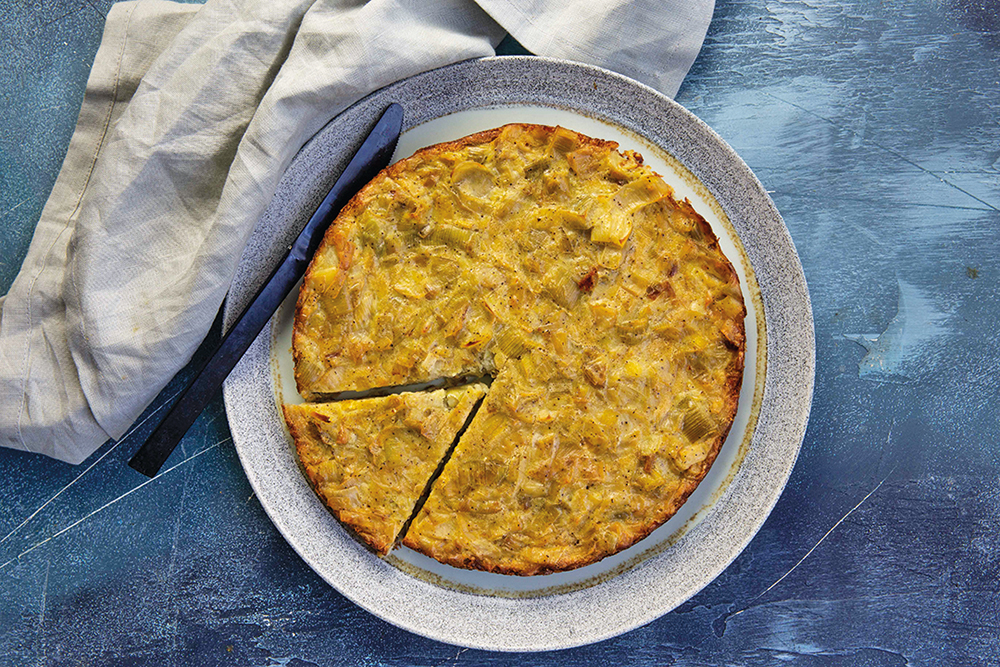
(Credit: Miriam (Pascal) Cohen)
The first Yom Tov I spent with my in-laws was Rosh Hashanah, which means that I didn’t have to wait long to be introduced to a beloved family favorite: my mother-in-law’s leek pie! She serves it for one of the Rosh Hashanah simanim, but with a little tweaking, I turned this delicious family favorite into a perfect Pesach side dish that presents beautifully and freezes well, too!
Pareve
Yields 2 pies,
6-8 servings each
Caramelized Leeks
- 2 Tablespoons olive oil
- 1 onion, diced
- 2 teaspoons kosher salt
- 6 large leeks, white and light green parts only, cut into
- half-moons
- 6 cloves garlic, minced
- ½ teaspoon ground black pepper
Batter
- 6 eggs
- ½ cup oil
- ½ cup potato starch
- 1 teaspoon kosher salt
- 1 teaspoon ground black pepper
Prepare the caramelized leeks: Heat oil in a large, deep frying pan over medium-high heat. Add onion and salt. Cook, stirring occasionally, for about 5 minutes, until softened.
Add leeks, garlic, and pepper. Reduce heat to medium-low; cook, stirring occasionally, for at least 15 minutes, preferably 30 minutes, until leeks are golden in color. Set aside to cool.
Prepare the pie: Preheat oven to 350°F. Grease 2 (9-inch) round pans well; set aside.
In a large bowl, whisk together eggs, oil, potato starch, salt, and pepper until combined.
Add cooled leek mixture. Stir to combine.
Divide mixture between prepared pans. Bake for 35-40 minutes, until the tops are golden brown.
Plan Ahead
Leek pie can be frozen, well wrapped, until ready to serve. Reheat, covered, until warmed through.
Onion-Smothered Flanken
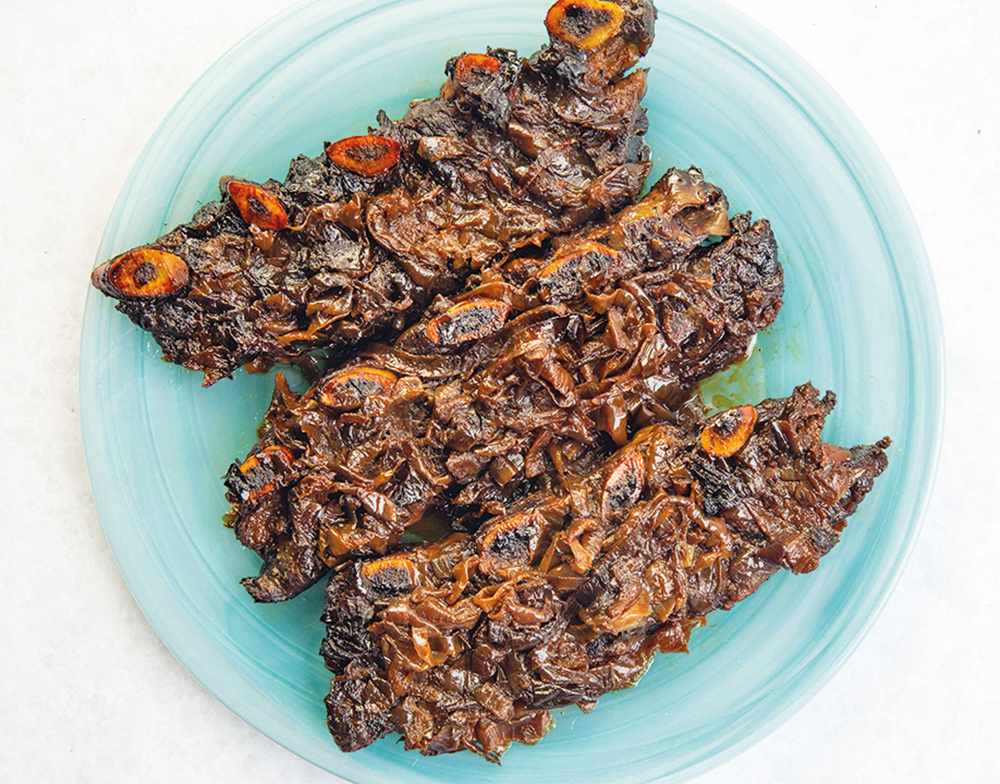
(Credit: Miriam (Pascal) Cohen)
When I think of Pesach food, it’s hard not to think about caramelized onions. When I was growing up, we didn’t use any spices on Pesach other than salt and pepper, so I learned from my mother to coax the maximum amount of flavor out of all the fruits and vegetables we cooked with. This melt-in-your-mouth flanken really doesn’t need much to be perfect. Just a heaping ton of onions and a whole lot of time in the oven makes for the most extraordinary meat you’ll enjoy all Pesach long.
Meat
Yields 6-8 servings
- 6-8 strips bone-in flanken
- kosher salt, for sprinkling
- ground black pepper,
- for sprinkling
- oil, for searing
- 2¼ cups Caramelized Onions
- (from 3 onion; page 264)
- 1 cup dry or semi-dry red wine
- 1 inch fresh ginger, minced,
- OR 2 frozen ginger cubes
- 2-4 Tablespoons sugar, optional
Preheat oven to 275°F. Prepare a large baking dish.
Sprinkle salt and pepper very generously over the entire surface of the meat. Turn meat; repeat on the second side.
In a large frying pan, heat oil over high heat. Add flanken; sear for 1-2 minutes per side, until the outside is nicely browned. Place into prepared baking dish. Spread caramelized onions over the meat.
In a small bowl, combine wine, ginger, and sugar (if using); pour over the flanken.
Cover tightly; bake for about 5 hours, until fork-tender.
Plan Ahead
This flanken freezes nicely, well wrapped. Rewarm, covered, until heated through.
Variations
Instead of flanken, you can use other cuts of meat that work well with a low and slow cooking method, such as second cut brisket, minute steak or minute roast.
Ultimate Pesach Chocolate Chip Cookies

(Credit: Miriam (Pascal) Cohen)
How many batches of a recipe must one bake to call it the “ultimate”? I don’t know, but I am pretty sure I passed it with these cookies! Because my year-round chocolate chip cookies are my ultimate, most famous, and most popular recipe, I knew I needed a Pesach cookie to rival it! I tried so many times, scrapped so many ideas and batches, until finally I was satisfied that I am indeed sharing the Ultimate Pesach Chocolate Chip Cookie recipe with you. Try these and I’m confident you’ll agree!
Pareve
Yields about 4 dozen
- 1 cup oil
- 1 cup brown sugar
- ½ cup sugar
- 1 egg
- 1 egg yolk
- 2 teaspoons vanilla extract
- 1 teaspoon baking soda
- ½ teaspoon baking powder
- ½ teaspoon sea salt
- 1 cup ground pecans
- 2 cups potato starch
- 2 cups almond flour
- 1 (9-oz) bag chocolate chips
Preheat oven to 375°F. Line 2 baking sheets with parchment paper; set aside.
In a large bowl, whisk or beat together oil, brown sugar, sugar, egg, egg yolk, vanilla, baking soda, baking powder, and salt until combined and creamy.
Stir in ground pecans, potato starch, and almond flour to form a cohesive dough. Stir in chocolate chips.
Roll heaping tablespoons of dough into balls. Place on prepared baking sheets. Bake for 9-10 minutes, until the tops are set.
Plan Ahead
Cookies can be frozen, well wrapped, until ready to serve.
Variations
You can bake these in numerous other forms, adjusting the baking time as needed.
Cookie sticks: 20-25 minutes.
Cookie pie: (inside a Pesach crust): about 35 minutes.
Jumbo cookies: 12-14 minutes. 9×13 bars: about 35 minutes.











